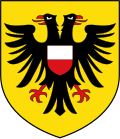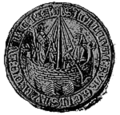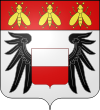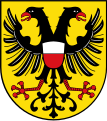Lübeck coat of arms
|
Hanseatic City of Lübeck State of Schleswig-Holstein |
|
|---|---|

|
|
| Blazon | |
Shield and eagle:
Breastplate:
|
|
| Basic data | |
| Introduction: | 1450 |
| Legal basis: | ... |
| Supporting documents: | January 26, 1937 Greater Hamburg Law² |
| Changes: | 1450 |
| swell | |
|
¹ Municipal coat of arms of Schleswig-Holstein |
|
The Lübeck coat of arms is a centuries-old city coat of arms or symbol of the city of Lübeck . For a long time, the Hanseatic city of Lübeck had two different coats of arms, which can also be found as double coats of arms : One with the imperial eagle as a symbol of imperial freedom (which the city enjoyed from 1226 to 1937) and one with the Hanseatic colors of silver divided over red, the so-called Lübeck shield .
Emergence
The origin of the Lübeck shield has not been proven with certainty; However, it is likely that this is derived from the Hanseatic flag , as is first documented on a ship's seal from 1230. The waving flag on the mast, it is assumed, already represents the colors red and white.
This is also the oldest reference to the city's own emblem. The imperial eagle appears a little later. The first evidence is coins from the beginning of the 14th century. The colors of the shield most likely do not come from the Counts of Holstein, but from the Reich coat of arms. After all, they can be found together on documents.
Coat of arms of the Free Imperial City
Finally around 1450 the two coats of arms were merged. The imperial eagle bore the Hanseatic coat of arms as a breast shield. It is one of the oldest coats of arms in Schleswig-Holstein among those listed today. The Flensburg coat of arms is of older origin.
The coat of arms in the French Empire
The Lübeck coat of arms from 1811 to 1813 led the city of Lübeck during its membership of the French Empire . After the incorporation of Lübeck into the French Empire on January 1, 1811, the city received a new coat of arms, which should replace the previous Lübeck coat of arms and underline Lübeck's position as a community within the French state. In this coat of arms, designed by the Conseil du Sceau , the traditional white and red coat of arms was on a pair of black eagle wings, which represented a rudimentary takeover of the previous Lübeck double-headed eagle . The combination of wings and coat of arms was on a silver (white) shield.
Since Lübeck had received the status of a Bonne Ville de l'Empire , i.e. a nominally special city of the French Empire, at the same time as it was incorporated into France , an element was added to the shield that was mandatory for all Bonnes Villes : a red shield head , in which were three golden imperial bees .
The coat of arms was given to Lübeck by a letter of coat of arms signed by Napoléon Bonaparte on June 13, 1811 and kept by the city until 1813. After the liberation from French rule and the restoration of independence as a city-state, the traditional coat of arms was reintroduced.
Coat of arms of the municipality
The Greater Hamburg Law of 1937 ended the city's imperial freedom by incorporating it into the State of Prussia and thus becoming part of Schleswig-Holstein . However, it allowed the old coat of arms to be continued.
- from 1784 until today
Mosaic on the lift bridge over the Elbe-Lübeck Canal below the castle gate
Coat of arms in a window of the imperial court building in Leipzig
Official city arms since 1997
Created by Prof. Kurt Weidemann
See also
literature
- Antjekathrin Graßmann (Ed.): Lübeckische Geschichte . Schmidt-Römhild, 1989.
Web links
- Schleswig-Holstein State Archives Local coat of arms of Schleswig-Holstein
- History of the coat of arms on the website of the Hanseatic City of Lübeck
- ngw.nl : The Lübeck coat of arms (engl.)
Individual evidence
- ↑ As an illustration e.g. B. on the engraving by Matthäus Merian : Lübeck 1641 They are also shown in Lübeck Town Hall and at the Holsten Gate .









